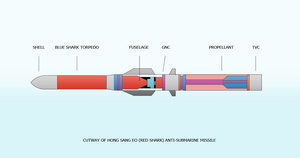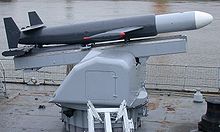Anti-submarine missile


An anti-submarine missile is a standoff anti-submarine weapon, often a specialized variant of anti-ship missile. Anti-submarine missile usually include a jet or rocket engine and a warhead aimed directly at a submarine. In these missiles, a torpedo or a depth charge is used as a warhead. The anti-submarine missile can be either a cruise missile or a ballistic missile.
History
[edit]
Depth charges were the earliest weapons designed for use by ships against submerged submarines. These explosives were initially dropped as the ship moved over the presumed location of a submarine. Before World War II, shipboard sonar was unable to maintain contact with a submarine at close range.
Various mortar-type projectors, including Hedgehog and Squid, were devised during World War II to allow a ship to maintain sonar contact while lobbing explosive charges toward the submarine.[1]
During the Cold War, missiles were developed to provide greater range with reduced recoil. Some missiles and rockets, such as Red Shark carry homing torpedoes to provide terminal guidance for the warhead.[2] The advantage of an anti-submarine missile is the attack stand-off range.
Examples
[edit]

- Australia
- France
- India
- Italy
- Japan
- People's Republic of China
- CJ-1 Torpedo
- CY Series
- South Korea
- Soviet Union/Russian Federation
- United Kingdom/Australia
- United States
References
[edit]- ^ Hughes, Terry, and Costello, John The Battle of the Atlantic (1977) Dial Press ISBN 0-8037-6454-2 pp.307-308
- ^ Albrecht, Gerhard Weyer's Warships of the World (1969) United States Naval Institute p.385
